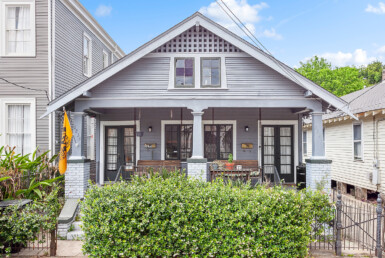Irish Channel

The Irish Channel has experienced an exciting growth spurt. The blighted houses that filled the district in the early 1990s are finding new buyers who often renovate them for their own homes, instead of rentals, which has helped to strengthen the area. Newly invigorated neighborhood groups working with Preservation Resource Center’s Rebuilding Together program have painted and repaired homes of elderly owners, and in doing so have helped to keep the neighborhood’s memory intact and its diversity alive. The suggestion that Irish immigrants lived in a defined zone is a bit misleading. The Irish Channel Historic District was actually an extremely diverse neighborhood of working class Irish, Germans, Italians, Americans and free people of color during the mid-19th century.
Established as the riverfront of the American city of Lafayette, the Irish Channel mushroomed into a busy area of wharves surrounded by lumberyards and cotton presses. Soapmaking and tanning factories were supplied by stockyards directly across the river in Gretna. Free of the political control of New Orleans’ conservative Creoles, residents of independent Lafayette voted taxes for the improvement of wharves and roads. Humbler buildings pushed out grand early residences as the waterfront became increasingly busy (although you can still find a mansion or two among the charming rows of smaller frame homes.) This neighborhood has significant ties to the development of jazz in the city. According to the National Register report, “The Irish Channel area gains its significance in music from the fact that many jazz musicians of German, French, Irish and Italian descent were born and reared here. All the members of the Original Dixieland Jazz Band, the first jazz band to make a phonographic record and the first to go to Europe, were from the Irish Channel. Tom Brown, George Brunies and his brothers, Tony Spargo, Nick LaRocca, Harry Shieldsand Eddie Edwards are some of the jazz immortals who came from the Irish Channel and helped spread jazz throughout the world.
“The Irish Channel has been the center of the St. Patrick’s Day celebration since 1809. Marchers parade between floats while riders toss cabbages, carrots, potatoes and onions to the crowd. New Orleanians often boil the vegetables in a stew. Revelers gather all day in the corner bars that have always been part of this neighborhood’s fabric, in good times and bad. The Irish Channel was hard hit after World War II when FHA-insured mortgages were basically restricted to the new suburbs. Vast sections of American cities were quietly redlined, destined to decay. “Twenty thousand men went to war from the Irish Channel, but when the war ended, they couldn’t get the financing to move back in,” a property assessor once told preservation activist Camille Strachan. In the 1970s, young do-it-yourself renovators rediscovered the neighborhood, but the oil crash of the ’80s ended that short boom period. Now the neighborhood is looking up again. The past ten years have been good. Today’s Irish Channel is a vibrant inner city neighborhood coming back to life by the vigilant attention of its residents. And shoppers from around the world flock to the design emporiums, spas and boutiques that increasingly choose to locate on Magazine Street.
Courtesy of the Preservation Resource Center of New Orleans.











